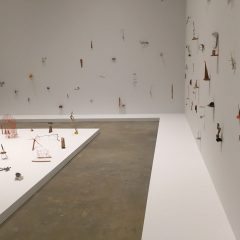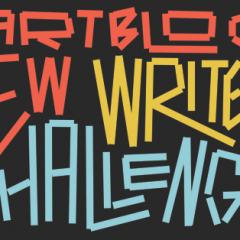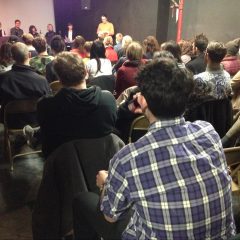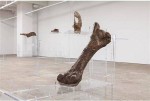[Dear Readers, we are publishing the essays of the 16 finalists in the New Art Writing Challenge Contest on Artblog and the St. Claire! Today, we publish the finalists in the category 1,000 words or less. Thanks to all those who participated and submitted more than 70 articles. And thanks to our jurors–Hrag Vartanian, Abigail Satinsky and Nell McClister–who picked the winners. We are energized by all the wonderful writing that was submitted and know you will enjoy reading it! — the Artblog editors]
Finalists in the category: 1,000 words or less
Incompatible with Life
By Ulrika Andersson and Kevin Travers
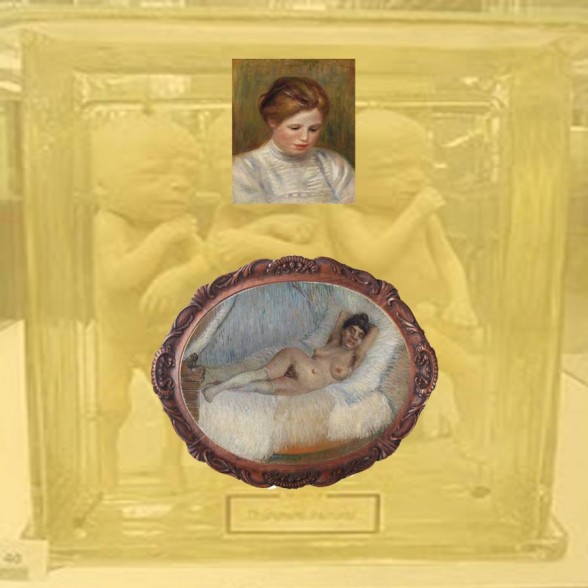
When we went into the Barnes I put the coat check ticket in his shirt front and called him Pocket Boy. I folded my entrance ticket in two and shoved it in my bra where it created a sticky hold to my skin.
The entrance is comically large, creating all the grandeur and importance of a museum that is immediately forgotten upon entering the rooms of art. A pretty Renoir girl with her hair pulled up in a bun wearing a white frock looks down studiously, or with consternation, at a Gauguin ‘Tahiti’ painting. What you would imagine to be a distracting way of hanging work, instead makes the pieces stand out as a point of interest to be glanced over or scrutinized.
It is spurious reasoning that says there is anything in particular to look for when entering a room of art. I make fast work of looking around the room to see if there is anything that is a bit illogical… an absurd turn in the jump of a joke that absolutely insists on itself. Something undeniable, but inexplicable. Something well done is inherent and can be enjoyed, but doesn’t need to be mulled over.
We walk around with the lack of self-consciousness afforded by a good hangover and are confronted by a wall of Renoirs with a naughty little boy dressed in blue as the centerpiece. I exclaim, “Oh No” aloud.
Fellow patrons clad in headphones, I am emboldened.
Pocket boy has just told me he has decided he doesn’t hate Renoir anymore. He likes his touch. A friend from the night before had declared, “I’ve never done anything gently in my life. I’ve been told I’m very heavy-handed.” All three of us would agree his light is disgusting.
De Chirico is a disappointment like it is every time in person. The hopes are always heightened by how the works look on a screen. “He was aware of the internet”-as opposed to Corot, who made a little painting of a very “chill” looking shepherd standing under a tree. We agree upon seeing that painting that Corot didn’t think about the internet at all.
There is a little harbor painted by Seurat and I see that he has painted a thin, dark blue and red border done in his pointillist style that is kind of wonky compared to the geometry of the rest of the painting. We agree it might have been a relief for him to do this border. I say to Kevin it makes you know him as a person, because you can tell that he liked to make those dots, and he didn’t need to be rendering something for it be worth doing.
Then we look at a Bosch that is packed with snarling figures, standing in a half-demolished castle with a big turret behind them. There’s a village on fire and everywhere you look there’s another person with distinct, ugly features and sinewy flesh and the painting is completely smooth. Everywhere you look there is more description and that in itself is horrifying. We can’t imagine what Bosch is like as a person.
Soutine has painted a skinned rabbit on his back, legs akimbo. The perspective is from directly above. Kevin tells me his teacher told him Soutine would starve himself before painting these. I am immediately affected in the way I had wanted to be but had alluded me the day before at the Mutter museum until we got to the jars of deformed fetuses. The labels identified the condition the fetuses suffered, one bearing the note “incompatible with life (lethal)”. Soutine at least makes me laugh a little though in its intensity. Those babies were so old and their flesh almost flocculent in the jars.
I keep wondering who this work is for. None of it feels like it’s been made for something, but they all have so much intent. They are so strange. We had talked about the intent in our own work and agreed art is not worth making unless it feels insistent. It does not have to be clear why, but it has to be imperative. Illustrating an idea or creating a mood or beauty is too thin, but it seems so popular. Aha! I get it. I like it. I hate it. Or there is work that is so obtuse it becomes immediately boring, and figuring it out is as rewarding as completing a Sudoku. It’s fine, but really it proves nothing. Fran Lebowitz says you don’t just need good artists but a vital audience. If we could all let go of the idea of the importance of our own legacy maybe the need for declarative retrospectives with their cycles of immediate backlashes and defenses might subside.
I saw a Madonna so vaginal in form I didn’t even see the Madonna for a few seconds. Perhaps the oval Van Gogh double vagina I declared my favorite from the room before is still on my mind. Kevin tells me that piece is a “unique choice”. It’s the most expertly executed manifestation of awkwardness I’ve ever seen.
You can run around the Barnes and play a game of rank ’em if you want. Here it’s actually fun because while doing it, the absurdity of choosing what’s your favorite is so apparent.
“Oh we didn’t look at the Renoir in here” Kevin said sending me into a fit of giggles so intense I need to sit down. He joins me. “Was Renoir gay?” I ask. He says maybe Renoir is one of those people like Degas: he was a much older man but actually identified with those young girls. Sort of like Lewis Carroll too. People wondered why he was hanging out with those teenage girls and photographing them. I have to come back another time to think about it. I’m at the end of a good, hard book and it’s good to start it again.
Ulrika Andersson teaches Art Appreciation online for Rutgers, is an artist assistant for AVAF, and has a pet portrait business. She listens to audiobooks when she works. She lives in Manhattan with her roommates.
Kevin Travers cooks at Kirkridge Retreat Center, near the Delaware Water Gap in Pennsylvania. He paints with an airbrush and reads books one page at a time. He currently lives on the campus of Kirkridge with his roommate.


